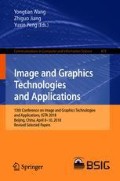Abstract
This paper proposed a saliency-dependent measure to predict visual comfort of stereoscopic. Considering the drawbacks of traditional stereoscopic display visual comfort assessment, a more accurate visual comfort prediction method based on improved stereoscopic saliency detection algorithm was proposed in this paper. The proposed approach includes 3 steps. The first step involves the calculation of region contrast, background prior, surface orientation prior and depth prior which aims to generate a stereoscopic saliency map. The second step is the extraction of visual comfort perception features. Finally, the prediction performance is evaluated by using SVR. The experimental results demonstrate that our method improves the prediction accuracy a lot compared with the related work.
Access this chapter
Tax calculation will be finalised at checkout
Purchases are for personal use only
References
Lambooij, M., Fortuin, M., Heynderickx, I.: Visual discomfort and visual fatigue of stereoscopic displays: a review. J. Imag. Sci. Technol. 53(3), 30201-1–30201-14(14) (2009)
Hoffman, D.M., Girshick, A.R.: Vergence–accommodation conflicts hinder visual performance and cause visual fatigue. J. Vis. 8(3), 33.1 (2008)
Choi, J., Kim, D., Ham, B.: Visual fatigue evaluation and enhancement for 2D-plus-depth video, pp. 2981–2984 (2010)
Lambooij, M., Ijsselsteijn, W.A., Heynderickx, I.: Visual discomfort of 3D TV: assessment methods and modeling. Displays 32(4), 209–218 (2011)
Jung, Y.J., Sohn, H., Lee, S.I.: Predicting visual discomfort of stereoscopic images using human attention model. IEEE Trans. Circ. Syst. Video Technol. 23(12), 2077–2082 (2013)
Sohn, H., Jung, Y.J., Lee, S.I.: Predicting visual discomfort using object size and disparity information in stereoscopic Images. Trans. Broadcast. 59(1), 28–37 (2013)
Li, H., Luo, T., Xu, H.: Saliency detection of stereoscopic 3D images with application to visual discomfort prediction. 3D Res. 8(2), 14 (2017)
Fan, X., Liu, Z., Sun, G.: Salient region detection for stereoscopic images. In: International Conference on Digital Signal Processing, pp. 454–458. IEEE (2014)
Itti, L., Koch, C., Niebur, E.: A model of saliency-based visual attention for rapid scene analysis. IEEE Trans. Pattern Anal. Mach. Intell. 20(11), 1254–1259 (1998)
Yang, C., Zhang, L., Lu, H.: Saliency detection via graph-based manifold ranking. In: Computer Vision and Pattern Recognition, pp. 3166–3173. IEEE (2013)
Li, J., Levine, M.D., An, X.: Visual saliency based on scale-space analysis in the frequency domain. IEEE Trans. Pattern Anal. Mach. Intell. 35(4), 996–1010 (2016)
Peng, H., Li, B., Xiong, W., Hu, W., Ji, R.: RGBD salient object detection: a benchmark and algorithms. In: Fleet, D., Pajdla, T., Schiele, B., Tuytelaars, T. (eds.) ECCV 2014. LNCS, vol. 8691, pp. 92–109. Springer, Cham (2014). https://doi.org/10.1007/978-3-319-10578-9_7
Cheng, H., Zhang, J., An, P.: A novel saliency model for stereoscopic images. In: International Conference on Digital Image Computing: Techniques and Applications, pp. 1–7. IEEE (2015)
Tang, C., Hou, C.: RGBD salient object detection by structured low-rank matrix recovery and Laplacian constraint. Trans. Tianjin Univ. 23(2), 176–183 (2017)
Chen, Q.X., Fu, L.H., Li, C.C.: A new depth saliency method based on selective difference, vol. 12, p. 03018 (2017)
Qu, L., He, S., Zhang, J.: RGBD salient object detection via deep fusion. IEEE Trans. Image Process. 26(5), 2274–2285 (2016)
Ren, J., Gong, X., Yu, L.: Exploiting global priors for RGB-D saliency detection. In: Computer Vision and Pattern Recognition Workshops, pp. 25–32. IEEE (2015)
Cheng, M.M., Mitra, N.J., Huang, X.: Salient object detection and segmentation. IEEE Trans. Pattern Anal. Mach. Intell. 37(3), 1 (2013)
Binocular, D.S., Motion, B., Parallax, M.: Perception of three-dimensional space: how do we use information derived from one or both eyes to perceive the spatial layout of our surroundings. In: Perception of the Visual Environment, pp. 257–294. Springer, New York (2002). https://doi.org/10.1007/0-387-21650-2_9
Ciptadi, A., Hermans, T., Rehg, J.: An in depth view of saliency. In: British Machine Vision Conference, pp. 112.1–112.11 (2013)
Lang, M., Hornung, A., Wang, O.: Nonlinear disparity mapping for stereoscopic 3D. ACM Trans. Graph. 29(4), 1–10 (2010)
Shao, F., Jiang, Q.P., Jiang, G.Y.: Prediction of visual discomfort of stereoscopic images based on saliency analysis. Opt. Precis. Eng. 22(6), 1631–1638 (2014)
IVY Lab stereoscopic image database. http://ivylab.kaist.ac.kr/demo/3DVCA/3DVCA.htm
Acknowledgement
This work has been supported by the National Technology Support Program of China (Grant No. 2015BAK01B05).
Author information
Authors and Affiliations
Corresponding author
Editor information
Editors and Affiliations
Rights and permissions
Copyright information
© 2018 Springer Nature Singapore Pte Ltd.
About this paper
Cite this paper
Du, M., Nie, G., Liu, Y., Wang, Y. (2018). Study on Comfort Prediction of Stereoscopic Images Based on Improved Saliency Detection. In: Wang, Y., Jiang, Z., Peng, Y. (eds) Image and Graphics Technologies and Applications. IGTA 2018. Communications in Computer and Information Science, vol 875. Springer, Singapore. https://doi.org/10.1007/978-981-13-1702-6_45
Download citation
DOI: https://doi.org/10.1007/978-981-13-1702-6_45
Published:
Publisher Name: Springer, Singapore
Print ISBN: 978-981-13-1701-9
Online ISBN: 978-981-13-1702-6
eBook Packages: Computer ScienceComputer Science (R0)

